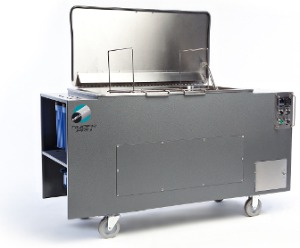How to use an Ultrasonic Cleaner for Vehicle Transmissions

Automobile transmission service companies, rebuilders and backyard mechanics can save a tremendous amount of time by using ultrasonic cleaning to remove dirt, grease, metal shavings and other deposits from valves, valve body casings and other intricate components. Potentially harmful solvent-based parts washers and aerosol sprays cannot compare with the cavitation cleaning action of an industrial or tabletop ultrasonic cleaner using biodegradable ultrasonic cleaning solutions, some of which are available with rust inhibitors.
How it Works
Regardless of size, all ultrasonic cleaning systems operate on the same general principal. Biodegradable cleaning solutions diluted to the manufacturers’ recommendations are added to the cleaning tank to the fill line. Attached to the tank are ultrasonic transducers tuned to specific ultrasonic frequencies such as 37 kHz (37,000 cycles per second). The transducers are driven by an ultrasonic generator affixed to the unit.
Disassembled transmission components are placed into mesh baskets taking care that they do not come into contact with each other. Large parts can be suspended from an overhead support. Nuts, bolts and other small parts can be loaded into fine screen baskets.
Turn on the ultrasonic cleaner and lower the components into the cleaning solution. The transducers generate myriad miniscule bubbles in the solution that implode violently when they contact parts being cleaned. The implosion is called cavitation action, which quickly and safely blasts away all contaminants on the parts. The bubbles penetrate all cracks, crevices and blind holes – areas almost impossible to reach by hand scrubbing in wash tanks. Generally the process is completed in 10 – 15 minutes although actual cleaning time depends on the condition and number of products placed into the solution.
At the conclusion of the cycle parts are removed from the bath and allowed to dry before reassembly.
Efficiency Tips
Regardless of the size of your ultrasonic cleaning bath, measures can be employed to increase its efficiency. For example, fresh cleaning bath solutions should be degassed to remove entrained air that will decrease the efficiency of cavitation action. This can be accomplished in about 45minutes by running the ultrasonic cleaner without parts in the solution. As an alternative, ultrasonic cleaners with a degas function can do the job in about 10 minutes.
Although fresh cleaning solutions are biodegradable they will absorb contaminants during cleaning cycles. Oils that rise to the surface should be skimmed off and disposed of properly. As the solution becomes dirty cleaning action will diminish. Drain the tank and likewise dispose of the solution in a proper manner. Take this time to clean the tank in order to remove heavy greases and damage-causing metallic contaminants that fall to the bottom. Follow the manufacturer’s recommendations for cleaning the tanks but in no case should you use an abrasive cleanser.
Industrial-size ultrasonic cleaners used by commercial transmission repair shops may be equipped with skimmers and filters to prolong the effectiveness of the cleaning solution.
Remember to always follow manufacturer’s recommendations in using and maintaining an ultrasonic cleaner. Contact the experts at Tovatech for further information on selecting a system that is tailored to your requirements.
How do you clean automotive transmissions and other automotive components? How much time savings have you experienced by using ultrasonic energy rather than conventional wash tanks?
——————————-